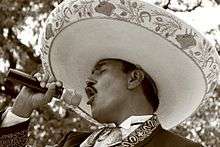Norteño (music)
Norteño or Norteña (Spanish pronunciation: [noɾˈteɲo], northern), also música norteña, is a genre of Regional Mexican music from Northern Mexico, hence the name. The music is most often based on a polka or waltz tempo and its lyrics often deal with socially relevant topics. The accordion and the bajo sexto are traditional norteño's most characteristic instruments. Norteña music developed in the late 19th century, as a mixture between German folk music (which was introduced to Mexico with the arrival of German migrant workers in those years), and local Northern Mexican music.
| Norteño | |
|---|---|
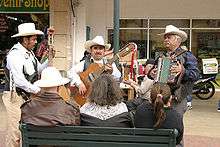 | |
| Stylistic origins | In Mexico: In Europe: |
| Cultural origins | Northern Mexico |
| Typical instruments | |
| Subgenres | |
| Norteño-Banda, Norteño-Sax | |
| Other topics | |
The genre is popular in both Mexico and the United States, especially among the Mexican and Mexican-American community, and it has become popular in many Latin American countries as far as Colombia, Chile, and Spain. Though originating from rural areas, norteño is popular in both rural and urban areas.
A conjunto norteño is a type of Mexican folk ensemble. It mostly includes diatonic accordion, bajo sexto, electric bass or double bass, and drums, and sometimes saxophone.
Repertoire
The norteño repertoire covers canción ranchera, corrido, ballad, bolero, chotís, cumbia, huapango norteño, mazurka, polka, redowa and waltz.[1]
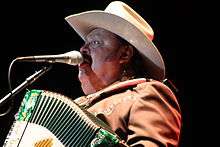 Ramon Ayala, a norteño musician known as the "King of the Accordion"
Ramon Ayala, a norteño musician known as the "King of the Accordion"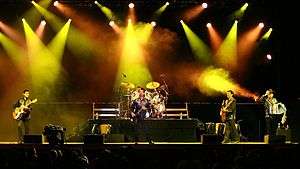 Los Tigres Del Norte performing at a Californian casino in 2006
Los Tigres Del Norte performing at a Californian casino in 2006
History
Origins
Emperor Maximilian I brought music from Europe to México. By 1864 he had accumulated marching bands and musicians to entertain him. When Maximilian's empire was defeated, many of his former army and fellow countrymen fled north and dispersed into what is now the southwestern United States. Norteño music developed from a blending of Mexican and Spanish oral and musical traditions, military brass band instrumentation, and Germanic musical styles such as polka and waltz.
European immigrants from Germany, Poland, and the Czech Republic to northern Mexico and the southwestern United States also brought dance traditions such as the varsovienne. The focus on the accordion in the music of their home countries was integrated into Mexican music, and the instrument is essential in the genre today. It was called norteño because it was most popular in the northern regions of Mexico.
The late 1910s and 1920s were the golden age of the corrido, a form of ballad. Mexicans on both sides of the border came to San Antonio, Texas, to record in hotels. Their songs memorialize the Mexican political revolution of the time. Los Alegres de Terán and Los Donneños were among the first norteño bands. Later in the century, the genre became more commercial with the works of Los Relámpagos del Norte and other groups. More recent bands such as Intocable integrate elements of rock music and other popular styles.
Modernization
Modern norteño has also diverged significantly from more original "oldie" norteño of pre-1950s artists such as Narciso Martínez. Since the 1970s and 1980s, electric bass guitars and a modern drum set have been added. The traditional bajo sexto-accordion style of Los Alegres de Terán and Los Donneños transformed into the modern style typical to that of Los Tigres del Norte, Los Tucanes de Tijuana, Intocable, and Duelo. Current songs may feature percussions, saxophone, or an electronic keyboard. In 2014, Los Tigres del Norte released the album Realidades, which contains the song “Era Diferente” (meaning “She Was Different”) about a lesbian teenager who falls in love with her best friend; according to lead singer and songwriter Jorge Hernández, this is the first time a norteño band has ever written a gay love song.[2][3]
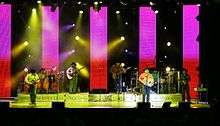 Intocable
Intocable A traditional norteño ensemble in Baja California, Mexico, consisting of an accordion, a tololoche and a snare drum ("tarola").
A traditional norteño ensemble in Baja California, Mexico, consisting of an accordion, a tololoche and a snare drum ("tarola").
Regional Variations
The norteño bands with the most traditional sounds come from Mexico’s northeastern states, while norteño bands from Mexico’s pacific states tend to play their music in a rougher manner and some replace the electric bass with a sousaphone (norteño-banda), and norteño bands who incorporate the saxophone into their music (norteño-sax) are primarily popular in Mexico’s landlocked states.
See also
References
- Instituto Nacional de Antropología e Historia (1988). Atlas cultural de México: Música. Mexico D. F.: Secretaría de Educación Pública, Instituto Nacional de Antropología e Historia : Grupo Editorial Planeta. ISBN 978-968-406-121-7.
- "Realidades - Los Tigres del Norte | Releases". AllMusic. 2014-10-07. Retrieved 2015-03-25.
- Yezmin Villarreal (2015-03-21). "Los Tigres del Norte Are Making Gay Norteño History". Advocate.com. Retrieved 2015-03-25.
